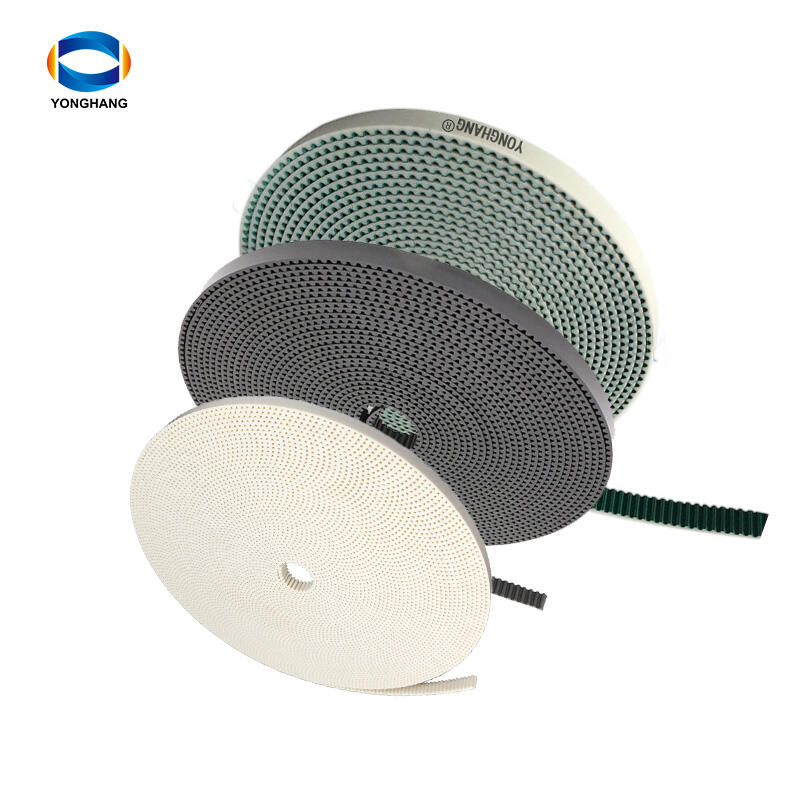Understanding PU Timing Belt Structure and Performance Factors
What is a PU Timing Belt and Why Maintenance Matters
PU timing belts are those special components used to transfer power precisely between parts of machines where synchronization matters. What makes them different from regular rubber belts? Well, they mix polyurethane material with internal tensile cords made of either steel or Kevlar. This combination gives them better strength and less stretching over time compared to standard alternatives. Maintenance really counts here too. According to research published in the Industrial Maintenance Journal back in 2022, about one out of every four machine failures in factories can be traced back to neglected timing belts. When these belts aren't properly cared for, it leads to expensive repairs and lots of lost production time when equipment stops working unexpectedly.
Key Components Affecting PU Timing Belt Performance
Three core elements determine performance:
- Tensile Cord Integrity: Steel or Kevlar cords provide high tensile strength, resisting stretch under load.
- Tooth Profile Precision: Accurate tooth geometry ensures smooth meshing with pulleys, minimizing slippage and noise.
- Environmental Resistance: Exposure to oils, temperatures above 185°F, or harsh chemicals accelerates degradation.
Even with robust materials, misaligned pulleys or incorrect tension can shorten belt life by up to 40%. Ensuring proper installation and alignment is as critical as material quality.
The Role of Material Composition in Durability and Wear
Polyurethane stands up really well against wear and tear, resists tearing, and doesn't support microbial growth which makes it great choice for places where hygiene matters most like food processing plants, pharmaceutical manufacturing areas, and cleanrooms. But watch out when temps get too hot or cold. Below around minus 40 degrees Fahrenheit or above about 220 degrees, the material starts losing its flexibility and becomes more brittle over time. Throw in some carbon black additive and suddenly those polyurethane components can handle UV exposure better. Manufacturers often reinforce backing layers with nylon to cut down on friction and prevent excessive heat buildup during operation. For long term performance, keep these belts stored somewhere away from ozone generators, electric motors running constantly, or welding stations since ozone will degrade the material quality pretty quickly.
Conducting Regular Inspections to Detect Early Signs of Damage
Inspecting for cracks, wear, or misaligned teeth in PU timing belts
Belts with cracks deeper than 1 mm or missing teeth will typically lose between 30 to 50 percent efficiency according to findings published in Industrial Power Transmission Journal last year. When checking belts, it helps to have good LED lights handy and give the pulley a slow rotation so all surfaces get inspected properly. Pay special attention to those areas around the base of each tooth and along the edges since these spots are where tiny cracks tend to start forming first. Another thing to watch for is misalignment, which usually shows up as strange wear patterns running across different parts of the belt width. This kind of irregular wear is a telltale sign something's off with how the belt tracks during operation.
Evaluating pulley conditions and alignment during routine checks
| Inspection Parameter | Tolerance Threshold |
|---|---|
| Pulley groove wear | ± 0.5 mm depth |
| Axial misalignment | ± 1° deviation |
| Radial runout | ± 0.3 mm |
Use laser alignment tools or straightedges for accuracy. Replace pulleys showing corrosion, deformation, or excessive groove wear—common contributors to premature belt failure according to power transmission research.
Using visual and tactile methods to identify common problems with timing belts
Trained operators detect 78% of early-stage defects using simple techniques:
- Tactile checks: Feel for thickness variations signaling internal delamination
- Visual comparison: Match against reference images of degraded belts
- Sound monitoring: Listen for irregular clicking during low-speed operation
In high-dust environments, conduct inspections every two weeks; monthly checks suffice in controlled settings. Record findings using standardized wear charts to track trends and forecast replacement needs.
Implementing Safe and Effective Cleaning Practices
Proper cleaning preserves PU timing belt efficiency and prevents premature wear. Contamination from dust, oil, and debris can reduce power transmission efficiency by up to 18% (Machinery Lubrication, 2023), underscoring the need for consistent cleaning protocols.
Why Cleaning a PU Timing Belt Is Important for Operational Efficiency
Accumulated contaminants impair grip between belt teeth and pulleys, leading to:
- Slip-induced torque loss
- Accelerated tooth wear
- Chemical degradation from residues
Regular cleaning maintains optimal engagement and extends service life.
Step-by-Step Guide to Safe Cleaning PU Timing Belts
- Dry brush loose particles with soft nylon brushes—never use metal bristles
- Apply a neutral pH cleaner using lint-free cloths; avoid alcohol or acidic solutions that degrade polyurethane
- Rinse gently with distilled water to prevent mineral deposits
- Allow full air-drying before reinstallation to avoid moisture-related slipping
Safety Tips During Cleaning to Avoid Damage or Injury
Wear nitrile gloves and eye protection when handling cleaners. Manually rotate the belt during cleaning—power tools may cause stretching or damage. According to industrial facility studies, proper PPE reduces chemical exposure incidents by 62% compared to improvised methods.
Preventive Measures to Reduce Contamination and Cleaning Frequency
Install ribbed belt guards to block up to 89% of airborne particulates (Bearing & Drive Systems, 2023). In high-debris areas, perform weekly compressed-air purges, keeping nozzles at least 6 inches from the belt surface to prevent abrasion.
Applying Correct Tension to Maximize PU Timing Belt Efficiency
Tension Adjustment for Timing Belts: Balancing Grip and Stress
Getting the right tension matters a lot actually. If it's too loose, belts slip around and get misaligned. But crank it up too tight and we end up putting extra strain on those teeth and bearings. According to some research from Bearing & Belt Research Group back in 2022, when tension isn't set properly, polyurethane belts just don't last as long – somewhere between 17% and 34% shorter lifespans. More recent findings from the Mechanical Drive Components Study in 2024 suggest sticking close to what manufacturers recommend makes all the difference. They mention checking things out either through Hz readings or measuring how much the belt bends under load as good ways to get those numbers right without guesswork.
Tools and Gauges Used in Belt Tension Measurement
- Tension meters: Non-contact sensors measure vibration frequency (Hz)
- Deflection rulers: Assess force required to depress the belt 10mm at midspan
- Smartphone apps: Some manufacturers offer sound-based tension analysis tools
Common Mistakes to Avoid During Tension Adjustment of PU Timing Belts
- Ignoring temperature effects: Polyurethane expands when heated—measure tension at operating temperature (±23°C/73°F)
- Overlooking pulley wear: Worn pulleys may require 8–12% higher tension for adequate grip
- Single-point measurement: Check tension at three or more locations to identify uneven loading
Pro Tip: Recheck tension after 48 hours of operation—new belts typically lose 5–7% tension during initial settling.
Extending Service Life Through Timely Replacement and Monitoring
Timing Belt Replacement Intervals Based on Usage and Environment
Replacement schedules should be usage-driven rather than time-based. High-load cycles, extreme temperatures, or abrasive environments may require changes 30–50% earlier than standard recommendations. For instance, belts in humid conditions are prone to moisture absorption, which compromises structural integrity over time.
Signs Indicating the Need for Immediate Replacement of PU Timing Belts
Replace immediately if you observe:
- Cracks wider than 1.5 mm
- Irregular tooth deformation or frayed edges
- Squealing noises during operation
- Inconsistent power transfer
Failure to act risks complete belt rupture and potential damage to pulleys, shafts, or connected components.
Case Study: Extended Belt Lifespan Through Predictive Maintenance
According to a recent 2023 study on maintenance practices, companies that implemented vibration sensors along with infrared thermography saw their PU belt lifespan increase by around 40% when compared to those who only reacted to problems as they happened. Take for instance an automotive manufacturing facility where unplanned stoppages dropped dramatically - down by nearly two thirds actually - once they started using real time monitoring systems. This matches what top researchers have been finding in their work on equipment lifecycles across different industries. Instead of changing belts at regular scheduled times regardless of condition, these plants now wait until the sensors tell them it's needed. This approach not only makes machines last longer but also saves money in the long run because parts aren't replaced prematurely.
FAQ Section
What is a PU timing belt?
A PU timing belt is a power transmission belt made of polyurethane materials and tensile cords, used in machinery to ensure synchronized power transfer.
Why is regular maintenance important for PU timing belts?
Regular maintenance of PU timing belts is important to prevent equipment failures, reduce repair costs, and avoid production downtime.
How can I tell if my PU timing belt needs replacement?
Signs indicating that a PU timing belt needs replacement include cracks wider than 1.5 mm, irregular tooth deformation, frayed edges, and squealing noises during operation.
What tools can be used to measure belt tension?
Tools for measuring belt tension include tension meters, deflection rulers, and smartphone apps with sound-based tension analysis capabilities.
How often should PU timing belts be inspected?
In high-dust environments, PU timing belts should be inspected every two weeks, while monthly checks are sufficient in controlled settings.
Table of Contents
- Understanding PU Timing Belt Structure and Performance Factors
- Conducting Regular Inspections to Detect Early Signs of Damage
- Implementing Safe and Effective Cleaning Practices
- Applying Correct Tension to Maximize PU Timing Belt Efficiency
- Extending Service Life Through Timely Replacement and Monitoring
- FAQ Section

 EN
EN
 AR
AR
 HR
HR
 DA
DA
 NL
NL
 FR
FR
 DE
DE
 EL
EL
 HI
HI
 IT
IT
 JA
JA
 KO
KO
 NO
NO
 PL
PL
 PT
PT
 RO
RO
 RU
RU
 ES
ES
 TL
TL
 IW
IW
 ID
ID
 SR
SR
 SK
SK
 UK
UK
 VI
VI
 TH
TH
 TR
TR
 AF
AF
 MS
MS
 IS
IS
 HY
HY
 AZ
AZ
 KA
KA
 BN
BN
 LA
LA
 MR
MR
 MY
MY
 KK
KK
 UZ
UZ
 KY
KY
